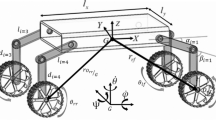Abstract
A reconfigurable 6R kinematic robotic model, named the Reconfigurable Puma–Fanuc (RPF) model, was developed by leveraging the similarities between different robotic systems in a unified approach. This model involves properties of all unified robots which allow the robot model to easily change from one configuration to another which produce this model to be reconfigurable. The objective of this study is to automatically generate dynamic equations for the RPF model. For the symbolic calculation of the RPF dynamic equations, the recursive Newton–Euler algorithm is employed using the symbolic algebra package MAPLE 10®. This dynamic model is named the Reconfigurable Puma–Fanuc Dynamic Model (RPFDM). The significance of the RPFDM is that it automatically generates each element of the inertia matrix A, Coriolis torque matrix B, centrifugal torque matrix C, and the gravity torque vector G using newly developed Automatic Separation Method (ASM). The RPFDM model is extended to the RPFDM+ model by coupling the dynamics of the actuator motors. As a numerical example, the dynamic equations for the PUMA 560 robot are obtained and compared to parameters presented in the literature.
Similar content being viewed by others
References
ElBeheiry EM, ElMaraghy WH, and ElMaraghy HA (2004) The structured design of a reconfigurable control process. Proc. CIRP Design Seminar, Cairo, Egypt
ElMaraghy HA (2006) Flexible and reconfigurable manufacturing systems paradigms. Int J Flex Manuf Syst l/17/4:261–276
Djuric AM, ElMaraghy WH (2006) Generalized reconfigurable 6-joint robot modeling. Trans CSME 30/4:533–565
Yoshida K, Ikeda N, Mayed H (1992) Experimental study of the identification methods for an industrial robot manipulator. IEEE/RSJ Int Conf Intell Robots Syst, Raleigh, pp 263–270
Park HS, Cho HC (1991) General design conditions for an ideal robotic manipulator having simple dynamics. Int J Robot Res 10/1:21–29
Ju MS, Mansour JM (1989) Comparison of methods for developing the dynamics of rigid body systems. Int J Robot Res 8/6:19–27
Izaguirre A, Hashimoto M, Paul RP, Hayward V (1992) A new computational structure for real-time dynamics. Int J Robot Res 11/4:346–361
Corke PI (1998) A symbolic and numeric procedure for manipulator rigid-body dynamic significance analysis and simplification. Robotica 16:589–594
Walker MW, Orin DE (1982) Efficient dynamic computer simulation of robotic mechanisms. J Dyn Syst Meas Control 104/3:205–210
Armstrong B, Khatib O, Burdick J (1986) The explicit dynamic model and inertia parameters of the PUMA 560 arm. IEEE International Conference on Robotics and Automation, 510–518
Corke PI, Armstrong B (1994) A search for consensus among model parameters reported for the PUMA 560 robot. Proc. IEEE Conf. Robotics and Automation, pp. 1608–1613
Burdick JW (1986) An algorithm for generation of efficient manipulator dynamic equations. IEEE Int Conf Robot Autom 3:212–218
Leahy MB, Nugent M Jr, Valavanis KP, Saridis GN (1986) Efficient dynamics for a PUMA-600. IEEE Int Conf Robot Autom 3:519–524
Rajagopalan R (1996) Distributed computation of inverse dynamics of robots. IEEE Comput. Soc. Press., pp. 106–112
Yamakita M, Hoshino Y, Morimoto K, Furuta K (1991) Parallel implementation of Newton–Euler algorithm with one step ahead prediction. IEEE Int Conf Robot Autom 2:1842–1849
Featherstone R, Orin D (2000) Robot dynamics: equations and algorithms. IEEE Int Conf Robot Autom 1:826–834
Palaz H, Kurugollu F, Bucak IO (1993) Parallel processing of the Newton–Euler equations of robot arm motion on a network of TMS320C25 processors. IEEE International Symposium on Industrial Electronics, pp. 352–357
Nathery JF, Spong M (1994) Robotica: a Mathematica package for robot analysis. IEEE Int Conf Robot Autom 1/1:13–20
Zomaya AY (1994) Extraction and computation of identifiable parameters in robot dynamic models: theory and application. IEE Proc Control Theory Appl 141/1:48–56
Corke PI (1996) An automated symbolic and numeric procedure for manipulator rigid-body dynamic significance analysis and simplification. IEEE Int Conf Robot Autom 2:1018–1023
Featherstone R, Orin DE (2000) Robot dynamics: equations and algorithms. IEEE Int Conf Robot Autom, 826–834
Li D, Xue D, Li T, Cui J, Xu X (2007) Dynamic model of a 3 DOF direct drive robot and its control model. IEEE Int Conf Control and Automation, 2694–2698
Mohan A, Saha SK (2007) A recursive, numerically stable, and efficient simulation algorithm for serial robots. Multibody Syst Dyn 17:291–319
Filipovic M, Potkonjak V, Vukobratovic M (2007) Humanoid robotic system with and without elasticity elements walking on an immobile/mobile platform. J Intell Robot Syst 48:157–186
Djuric AM, ElMaraghy WH (2007) A unified reconfigurable robots Jacobian. Proc 2nd Int Conf Changeable, Agile, Reconfigurable and Virtual Production 811–823 (CARV 2007)
Denavit J, Hartenberg RS (1955) A kinematic notation for lower-pair mechanisms based on matrices. J Appl Mech 77/22:215–221
Pieper DL (1968) The kinematics of manipulators under computer control. Computer Science Department, Stanford University, Artificial Intelligence Project Memo 72
Spong M, Vidyasagar M (1989) Robot dynamics and control. Wiley, New York
Fu KS, Gonzalez RC, Lee CSG (1987) Robotics: control, sensing, vision, and intelligence. McGraw-Hill, New York pp.12-82
Owens JP (1990) Industrial robot simulation. Ph.D. Thesis, Department of Electrical and Electronic Engineering, University of Newcastle Upon Tyne, UK
Vukobratovic M, Stokic D, Kircanski N, Kircanski M, Hristic D, Karan B, Vujic D, Djurovic M (1986) Introduction to robotics. Institute Mihailo Pupin, Belgrade
Author information
Authors and Affiliations
Corresponding author
Rights and permissions
About this article
Cite this article
Djuric, A.M., ElMaraghy, W.H. Automatic separation method for generation of reconfigurable 6R robot dynamics equations. Int J Adv Manuf Technol 46, 831–842 (2010). https://doi.org/10.1007/s00170-009-2156-y
Received:
Accepted:
Published:
Issue Date:
DOI: https://doi.org/10.1007/s00170-009-2156-y




